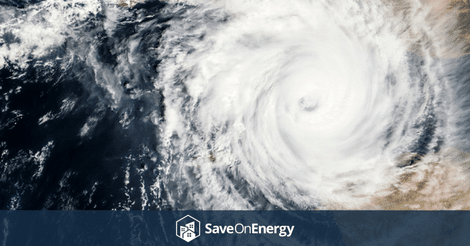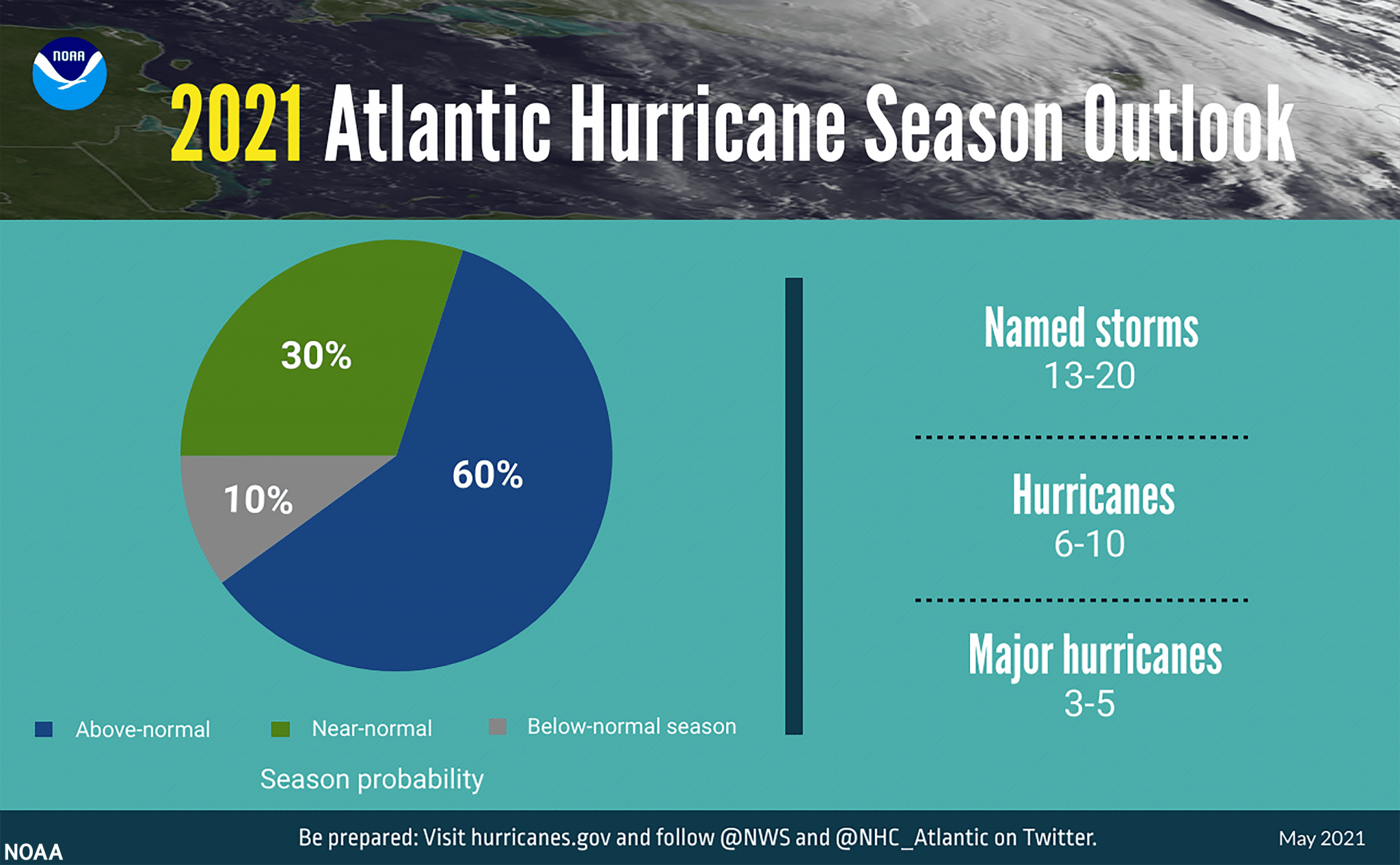Hurricane season in the U.S. reaches its peak from August to October, but that doesn’t mean they can’t hit earlier or later. The season runs from June to November, making now the perfect time to prepare for the weather to come throughout the summer and fall.

Let’s take a look at this year’s forecast and a pre-storm checklist that will see you through the season safely.
Understanding hurricane terminology
The first step to being prepared is understanding what weather reports are saying. When it comes to hurricanes, there are a few key terms to know:
- Hurricane watch. This means the area may see hurricane conditions in the next 48 hours.
- Hurricane warning. This means the area will see sustained winds of 74 mph or higher in the next 36 hours.
- Named storm. This is a storm that causes winds of 39 mph or higher. Storms are reclassified as hurricanes when winds reach 74 mph or higher.
- Major hurricane. This is the name for hurricanes that fall into Categories 3-5 on the wind scale, with five being the highest.
Major hurricanes are capable of extreme damage, including uprooted trees, flooding, downed power lines, and extended outages, as well as home destruction.
2021 hurricane season predictions
The National Oceanic and Atmospheric Administration (NOAA) is once again predicting an “active Atlantic hurricane season,” although not to the “historic level of storm activity seen in 2020.”
The predictions include:
- 13 to 20 named storms
- 6 to 10 of which become hurricanes (74 mph winds or higher)
- 3 to 5 of which become major hurricanes (Category 3, 4, or 5)
For context, the NOAA states that “an average hurricane season produces 14 named storms, of which 7 become hurricanes, including three major hurricanes. While there is a chance this season may be less severe than anticipated, NOAA is recommending all residents in hurricane zones begin to prepare now.

[Image from National Oceanic and Atmospheric Administration]
How to prepare for a hurricane
Preparing for a hurricane starts long before a watch or warning arrives. Start with preventative measures that won’t impact your daily life but will make it easier to get ready when storms arrive. When the weather turns, follow up with a few extra protections.
At the beginning of the season:
- Create an emergency kit. This includes any essential supplies you’ll need to survive for a few days. And don’t forget to include a list of emergency contact phone numbers too!
- Install hurricane-proof windows and shutters. This is a larger upgrade that could pay off big time when it protects the inside of your home from storm wreckage.
- Buy surge protectors. Plug small electronics into these so it’s easy to switch everything off at once.
- Set your refrigerator and freezer to the coldest temperature. This way, food will stay fresh for as long as possible if the power goes out.
- Designate a safe room. Pick an interior room without windows and make sure everyone knows where it is.
- Know your building. Talk to your landlord about the power-outage protocol for apartments or condos with elevators or a key card door entry systems. If you have a garage, make sure you know how to open it manually.
When a hurricane watch or warning is called:
A watch means that weather conditions could create a storm. A warning means that a storm is expected to be in a given area. Start preparing when a watch is called to make sure you have time to get ready.
What to do when there is a hurricane watch:
- Charge all cell phones and other devices that you may need during a power outage. This list may include electronics such as laptop computers and headphones, or medical equipment, such as a portable oxygen tank.
- Make sure any backup power sources are ready to operate safely.
- Have flashlights available for your household.
- Freeze containers of water in case of a power outage.
What to do when there is a hurricane warning:
- Bring patio furniture inside. This will minimize the risk of dangerous debris blowing around. Do this early on or not at all – do not go outside if the wind gets too strong,
- Unplug appliances and large electronics. This will protect them (and you) from electrical surges and floodwater.
- Prepare your safe room. Gather all family members and make sure all your essential supplies are in the room with you.
How to prepare your emergency kit
You should always have an emergency kit in your home, but especially during hurricane season. This kit should include everything you and the members of your household need to survive for at least 72 hours. This includes:
- Clean water. Tap water may not be safe to drink after an emergency. Keep one gallon of water per person per day.
- Non-perishable foods. This includes canned goods, dried fruits, and any other long-lasting items. Don’t forget infant formula, if necessary, or food for your pet.
- Backup power. Bring batteries and chargers for phones and flashlights. If you have a generator, you can use this for essential appliances.
- Prescription medications. Store essentials in a dry, sealed container.
- First aid kit. Stocked with gauze, bandages, tweezers, alcohol swabs, and other sterile items.
- Sleeping bags and pillows. Seal these in a waterproof bag.
- Clean clothes. Take at least one extra outfit per family member.
- Cash. ATMs and card readers may be down.
- Whistle or flares. Or anything else to help you get someone’s attention.
- Face masks. Bring coverings for everyone ages two and above, as well as soap and hand sanitizer, as needed.
This is just a small selection of everything you could include in your kit. It will depend on the members of your household and your needs. For more options, see the Department of Homeland Security’s full list.
How to survive without electricity after a hurricane
You’ve prepared for hurricane season, and now the storm has passed. Oftentimes, hurricanes of a Category between one and three may not cause extreme damage to your home or property but still may leave you without power.
Dealing with an extended power outage of several days to a few weeks can be a big headache. Here are some tips on how to survive when the power grid is down.
Cooking without power
NEVER use any type of grill, generator, or camping stoves in your home, including in your basement, garage, or carport. According to the Centers for Disease Control and Prevention (CDC), grills, generators, and stoves should be used outdoors at least “20 feet from any window, door, or vent.”
- Use charcoal grills or grills with propane tanks to heat food.
- If you don’t have a grill, you can also use a camping stove or even an outdoor fire pit.
- Use perishables first, then move on to your pantry items. Food in your refrigerator will stay cold for about four hours and freezer for about 24 hours. Opening the doors as little as possible will maintain the cold for longer.
Hygiene
- Flush toilets manually by pouring water in the tank up to a couple of inches below the overflow tube.
- Use hand sanitizer to clean your hands.
- Use wet wipes or baby wipes to stay clean.
- You may still be able to shower, depending on the type of hot water tank you have. If you use an electric pump to get water from a well or have an electric or gas-powered tank that uses electricity, then you will only be able to use the water remaining in your tank at the time of the outage. However, if you have a gas water heater with a continuous pilot light, you should be able to shower throughout a power outage.
- You can collect water in buckets, your washing machine, or a bathtub prior to a storm to use for general cleaning. However, do not use stored water or water that may be contaminated for activities such as food preparation (including baby formula), brushing your teeth, or washing dishes.
Keep cool
- Sleep downstairs and with the windows open. Remember, heat rises, so staying downstairs can be up to 10 degrees cooler. Keeping the windows open will allow for a cross-breeze.
- A battery-powered fan is a must if you want to stay comfortable during a power outage, especially if you live in a humid climate. And there are plenty of cooling options: you can use a fan with a long-lasting lithium-ion battery, individual handheld fans for each family member, or invest in a solar-powered fan. You can even find a fan that sprays a cool mist as well.
- Use water. Evaporation can help cool you down. Different techniques include getting your hair wet, spraying yourself with water, or wearing a hat or bandana that has been dipped in water.
- Stay shaded. Remain in the shadiest part of your property (as long as no trees or debris are at risk of falling).
Entertainment
- Conserve your cell phone battery in case of an extended power outage. Don’t use all your battery playing games on your phone.
- A power outage is a perfect time to break out the old-school, non-electronic games. Keep your family entertained with cards, board games, or even lawn games, such as cornhole or ladder golf.
- For the smallest members of your family, a coloring book or sidewalk chalk could come in handy.
- Books, magazines, crossword puzzles, and sudoku can help pass the time.
- Of course, if more people are outside after a power outage, it could be a good time to reconnect with your neighbors or lend a hand to anyone who needs help cleaning up.
What not to do during a hurricane
As with any emergency, there are also a few things you absolutely should not do during a hurricane. Stay away from all bodies of water and avoid stepping in puddles. Be especially aware in areas near downed power lines or damaged electrical equipment. During a hurricane, you may notice a period of calm. Do not go outside until you have confirmation that the storm is over. Additionally, don’t drink the tap water until you have heard from local authorities that it is safe.
Throughout the season, be overly cautious and make sure to pay attention to all weather alerts, regardless of what you’re seeing outside your window. Prepare now to keep yourself and your family safe later. Visit the National Hurricane Center for current alerts and more information.





